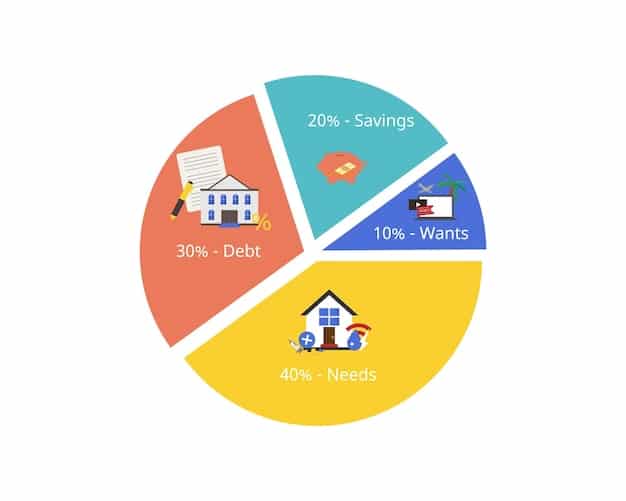Maximize Your 529 Plan Contributions Before the 2025 Deadline

Maximizing your 529 plan contributions before the 2025 deadline can provide significant tax advantages and help secure future educational expenses, but strategic planning is essential to fully leverage its benefits.
Are you looking to secure your child’s educational future while taking advantage of tax benefits? The upcoming 2025 deadline presents a crucial opportunity to maximize your 529 plan contributions. Understanding the strategies and implications can make a significant difference in your savings and long-term financial planning.
Understanding the 529 Plan Basics
A 529 plan is a tax-advantaged savings plan designed to encourage saving for future education costs. It’s a valuable tool, but understanding its mechanics is the first step in maximizing your contributions effectively.
What is a 529 Plan?
A 529 plan, also known as a qualified tuition plan, is a savings plan offering tax benefits when used for qualified education expenses. These plans are typically sponsored by states, state agencies, or educational institutions and come in two primary types: prepaid tuition plans and education savings plans.
Prepaid tuition plans allow you to purchase tuition credits at today’s prices for future use at participating colleges and universities. Education savings plans, on the other hand, are investment accounts where your contributions can grow tax-deferred, and withdrawals for qualified education expenses are tax-free.
Key Benefits of a 529 Plan
The advantages of using a 529 plan extend beyond just saving for college. The tax benefits, flexibility, and control make it a compelling option for many families. Understanding these benefits can highlight why maximizing your contributions is a worthwhile endeavor.
- Tax-Deferred Growth: Earnings in a 529 plan grow tax-deferred, meaning you don’t pay taxes on the investment gains until you withdraw the money.
- Tax-Free Withdrawals: When used for qualified education expenses such as tuition, fees, books, and room and board, withdrawals are tax-free at the federal level. Many states also offer state income tax benefits.
- Flexibility: 529 plans can be used at any accredited college, university, or vocational school in the United States, and even some abroad.
- Control: As the account owner, you maintain control over the assets in the 529 plan, even after the beneficiary reaches college age.
In summary, a 529 plan offers a potent combination of tax advantages, flexibility, and control, making it an attractive vehicle for funding education expenses. With a clear understanding of the plan’s basics, you can move forward with strategies to maximize your contributions and savings before the 2025 deadline.
Contribution Limits and Strategies
Navigating the contribution limits of a 529 plan can seem daunting, but strategic planning can help you make the most of your contributions. These plans provide flexibility and the ability to frontload contributions.
Annual Contribution Limits
The annual contribution limit for 529 plans is tied to the federal gift tax exclusion, which is \$18,000 per individual in 2024. This means that an individual can contribute up to \$18,000 to a 529 plan without incurring gift tax consequences. Married couples can each contribute \$18,000, effectively doubling the annual contribution to \$36,000 per beneficiary.
It’s important to note that these limits are per beneficiary, not per account. If you have multiple beneficiaries, you can contribute up to the annual limit for each of them. Staying within these limits is essential to avoid potential tax penalties.
The Superfunding Strategy
One of the most significant advantages of a 529 plan is the ability to use a superfunding strategy. This allows you to contribute up to five years’ worth of annual gift tax exclusions in a single year. For example, an individual could contribute up to \$90,000 (5 x \$18,000) in 2024. Married couples can contribute up to \$180,000 (2 x \$90,000).
However, when using the superfunding strategy, it’s crucial to file IRS Form 709 (United States Gift (and Generation-Skipping Transfer) Tax Return) to report the election to treat the contribution as if it were made ratably over a five-year period. This ensures that you comply with IRS regulations and avoid any unexpected tax consequences.
Spreading Contributions Over Time
Not everyone can afford to make large, lump-sum contributions. Spreading contributions over time is a practical way to maximize your 529 plan without straining your finances. Regular, smaller contributions can add up significantly over the years, thanks to the power of compounding.
- Automated Contributions: Set up automatic monthly or quarterly contributions to your 529 plan to ensure consistent saving.
- Milestone Contributions: Contribute additional amounts during significant milestones such as birthdays, holidays, or financial windfalls.
- Employer Contributions: Explore whether your employer offers any matching contributions or incentives for contributing to a 529 plan.
In conclusion, understanding and strategically using contribution limits can substantially boost your 529 plan savings. Whether through annual contributions, superfunding, or regular investments, consistent and informed planning is essential.

Tax Benefits and Implications for 2025
Tax benefits are a cornerstone of 529 plans, yet changes in legislation can impact these advantages. Staying informed about the tax implications, especially with the impending 2025 deadline, is crucial.
Federal Tax Benefits
One of the most compelling reasons to utilize a 529 plan is the significant federal tax benefits it offers. Contributions to a 529 plan are not deductible at the federal level, but the earnings grow tax-deferred. More importantly, withdrawals for qualified education expenses are entirely tax-free.
Qualified education expenses include tuition, fees, books, supplies, and equipment required for enrollment or attendance at an eligible educational institution. They also cover room and board if the beneficiary is enrolled at least half-time. The tax-free nature of these withdrawals makes a substantial difference over the long term, allowing your savings to grow without being eroded by taxes.
State Tax Benefits
In addition to federal tax advantages, many states offer their own tax benefits for contributing to a 529 plan. These benefits can include state income tax deductions or credits for contributions made to the plan. However, the specifics vary widely from state to state.
For example, some states may offer a full deduction for contributions up to a certain amount, while others may provide a partial deduction or a tax credit. It’s essential to research the specific rules and regulations in your state to understand the potential state tax benefits of contributing to a 529 plan.
Potential Tax Law Changes in 2025
The tax landscape is subject to change, and the year 2025 is significant because many provisions of the Tax Cuts and Jobs Act of 2017 are set to expire. This could lead to significant changes in tax laws, including those affecting 529 plans. Understanding the potential implications of these changes is critical for long-term planning.
- Monitor Legislative Updates: Stay informed about any proposed changes to tax laws that could affect 529 plans.
- Consult a Tax Advisor: Seek professional advice from a qualified tax advisor to understand how potential tax law changes might impact your 529 plan strategy.
- Adjust Contributions: Depending on the potential changes, consider adjusting your contribution strategy to take full advantage of current tax benefits before they expire.
In conclusion, tax benefits, both at the federal and state levels, play a pivotal role in the attractiveness of 529 plans. Staying informed about potential tax law changes and aligning your strategy accordingly is key to maximizing these benefits.
Impact of Market Fluctuations on 529 Plans
Investment growth is a core component of 529 plans, making them susceptible to market fluctuations. Savvy investors should understand how to navigate these changes to protect and grow their educational savings.
Understanding Market Volatility
Market volatility refers to the degree of variation in trading prices over a given period. It is a natural part of the investment landscape, influenced by various factors such as economic news, geopolitical events, and investor sentiment. Understanding how market volatility can impact your 529 plan is crucial for making informed decisions.
When the market is volatile, the value of investments in your 529 plan can fluctuate significantly in a short period. This can be concerning, especially as you approach the time when you need to withdraw funds for education expenses. However, it’s important to remember that 529 plans are designed as long-term investments.
Strategies to Mitigate Risk
While market volatility is unavoidable, there are strategies you can use to mitigate its impact on your 529 plan. These strategies focus on diversification, asset allocation, and maintaining a long-term perspective.
Diversification involves spreading your investments across different asset classes, such as stocks, bonds, and real estate. This reduces the risk of significant losses if one particular asset class performs poorly. Asset allocation involves adjusting the mix of assets in your portfolio based on your risk tolerance and time horizon.
Long-Term Investment Perspective
One of the most effective strategies for weathering market fluctuations is to maintain a long-term investment perspective. 529 plans are designed to be long-term savings vehicles, and the benefits of compounding returns accrue over time.
- Avoid Panic Selling: Resist the urge to sell your investments during market downturns, as this can lock in losses.
- Dollar-Cost Averaging: Consider using dollar-cost averaging, which involves investing a fixed amount of money at regular intervals, regardless of market conditions.
- Rebalance Regularly: Periodically rebalance your portfolio to maintain your desired asset allocation.
In summary, understanding and managing the impact of market fluctuations is crucial for maximizing the growth potential of your 529 plan. By staying informed, diversifying your investments, and maintaining a long-term perspective, you can navigate market volatility and secure your educational savings.

Qualified vs. Non-Qualified Expenses
Understanding what constitutes a qualified education expense is critical for avoiding penalties and maximizing the tax benefits of your 529 plan. Distinguishing between eligible and ineligible expenses is key.
Defining Qualified Education Expenses
Qualified education expenses are those that are necessary for attending an eligible educational institution. These expenses are tax-free when withdrawn from a 529 plan. The definition of qualified expenses is broad but specific.
Key qualified expenses include: tuition and fees, books, supplies, and equipment required for enrollment or attendance, room and board (if the beneficiary is enrolled at least half-time), and certain expenses for students with special needs. These expenses must be directly related to the student’s education.
Non-Qualified Expenses and Penalties
Non-qualified expenses are those that do not meet the IRS criteria for education-related costs. Withdrawing funds for non-qualified expenses can trigger taxes and penalties, diminishing the benefits of the 529 plan. It’s crucial to understand these to avoid unnecessary financial setbacks.
Examples of non-qualified expenses include: student loan payments (with some exceptions), expenses not directly related to education (such as transportation costs or entertainment), and expenses that are reimbursed by scholarships or grants. Withdrawing funds for these purposes is considered a non-qualified withdrawal.
Strategies to Avoid Penalties
Avoiding penalties associated with non-qualified withdrawals requires careful planning and diligence. Proper documentation, strategic timing, and understanding the plan’s rules are essential.
- Maintain Detailed Records: Keep records of all expenses to demonstrate that withdrawals were used for qualified purposes.
- Coordinate with Other Savings: Coordinate your 529 plan withdrawals with other savings or financial aid to minimize the need for non-qualified withdrawals.
- Consider Rollovers: If the beneficiary decides not to attend college, consider rolling over the 529 plan to another eligible family member.
In conclusion, differentiating between qualified and non-qualified expenses is vital for maximizing the benefits of a 529 plan. Knowing what expenses are eligible and implementing strategies to avoid penalties ensures your savings are used efficiently for education.
Estate Planning and Gifting Strategies
Beyond direct savings, 529 plans offer unique advantages for estate planning and gifting. Using these strategies can maximize the financial impact for future generations.
Using 529 Plans for Estate Planning
529 plans can be a valuable tool in estate planning, allowing you to transfer wealth to future generations while potentially reducing estate taxes. Contributions to a 529 plan are considered completed gifts, removing the assets from your taxable estate.
This can be particularly beneficial for individuals with large estates who want to minimize their estate tax liability. By contributing to a 529 plan, you can provide for your loved one’s education while reducing the overall value of your estate.
Gifting Strategies and Tax Implications
The gifting strategies associated with 529 plans offer significant tax advantages. As mentioned earlier, contributions to a 529 plan are treated as gifts, and they fall under the annual gift tax exclusion. In 2024, this exclusion is \$18,000 per individual, per beneficiary.
One strategy to maximize gifting is the superfunding option, which allows you to contribute up to five years’ worth of annual gift tax exclusions in a single year. For instance, you could contribute up to \$90,000 to a 529 plan without incurring gift tax consequences, provided you elect to treat the contribution as if it were made ratably over a five-year period.
Considerations for Grandparents
Grandparents often play a crucial role in funding their grandchildren’s education. 529 plans provide an excellent vehicle for them to contribute to their grandchildren’s future while potentially reducing their own estate tax liability.
- Direct Contributions: Grandparents can make direct contributions to their grandchildren’s 529 plans, taking advantage of the annual gift tax exclusion.
- Account Ownership: Grandparents can also establish and own the 529 plan, maintaining control over the assets.
- Coordination with Parents: It’s essential for grandparents to coordinate with the parents to ensure that contributions align with the overall financial plan.
In conclusion, estate planning and gifting strategies can significantly enhance the benefits of a 529 plan. By leveraging these strategies, you can provide for future generations’ education while optimizing your estate plan.
Reviewing and Adjusting Your 529 Plan
A 529 plan is not a set-it-and-forget-it investment. Regular reviews and adjustments are essential to ensure that the plan continues to meet your goals and adapt to changing circumstances.
The Importance of Regular Reviews
Regularly reviewing your 529 plan is essential to ensure that it aligns with your financial goals and adapts to changing circumstances. Market conditions, family needs, and legislative changes can all impact the performance and suitability of your plan.
During a review, assess: investment performance, contribution strategy, beneficiary needs, and tax implications. This holistic approach ensures that your 529 plan remains effective.
Adjusting Your Investment Strategy
As your beneficiary gets closer to college age, adjusting your investment strategy is crucial to protect your savings from market volatility. As the time horizon for using the funds decreases, shift the portfolio to more conservative investments.
Consider strategies such as: rebalancing the portfolio, reducing exposure to stocks, and increasing allocation to bonds or money market funds. These approaches can safeguard your investments as college approaches.
Updating Beneficiary Information
Life circumstances change, and it may become necessary to update the beneficiary information on your 529 plan. 529 plans provide flexibility in changing beneficiaries to accommodate these shifts.
- Eligible Family Members: The beneficiary can be changed to another eligible family member, such as a sibling, parent, or other relative.
- Tax-Free Rollover: The rollover to another eligible family member is generally tax-free.
- Documentation: Ensure proper documentation and compliance with the plan’s rules when changing beneficiaries.
In conclusion, a 529 plan requires ongoing attention and adjustments to remain effective. By regularly reviewing your plan, calibrating your investment strategy, and updating beneficiary information as needed, you can make sure that your investment meets the evolving needs of your family.
4️⃣ Key Deadlines: Superfund contributions before 2025 to maximize benefits.
➡️ Qualified vs. Non-Qualified: Ensure expenses align with IRS guidelines to avoid penalties.
📈 Market Fluctuations: Diversify investments to mitigate market volatility’s impact.
🎁 Estate Planning: Utilize 529 plans to reduce estate taxes and gift strategically.
“`
Can I change the beneficiary? It depends on the plan, but many allow you to change the beneficiary to a qualifying family member. Be sure to check your plan’s specifics.
“`html
What happens if my child doesn’t go to college? You have several options, including changing the beneficiary, waiting to see if they change their mind, or taking a non-qualified withdrawal, which may incur taxes and penalties.
Are contributions tax-deductible? At the federal level, no. However, many states offer some form of state income tax deduction or credit for contributions to a 529 plan.
How does a 529 plan affect financial aid? A 529 plan is generally treated as an asset of the parent, which has a minimal impact on financial aid eligibility compared to if it were considered the student’s asset.
How do I choose the right 529 plan? Consider factors such as investment options, fees, state tax benefits, and the plan’s overall track record before making a decision. Compare several plans to find the one that best fits your needs.
In conclusion, with careful planning and strategic contributions, you can harness the full potential of a 529 plan to secure your children’s educational future while enjoying its unique financial advantages.
Read more content





